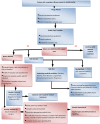2009 pandemic influenza A (H1N1) virus outbreak and response--Rwanda, October, 2009-May, 2010
- PMID: 22745652
- PMCID: PMC3383749
- DOI: 10.1371/journal.pone.0031572
2009 pandemic influenza A (H1N1) virus outbreak and response--Rwanda, October, 2009-May, 2010
Abstract
Background: In October 2009, the first case of pandemic influenza A(H1N1)pdm09 (pH1N1) was confirmed in Kigali, Rwanda and countrywide dissemination occurred within several weeks. We describe clinical and epidemiological characteristics of this epidemic.
Methods: From October 2009 through May 2010, we undertook epidemiologic investigations and response to pH1N1. Respiratory specimens were collected from all patients meeting the WHO case definition for pH1N1, which were tested using CDC's real time RT-PCR protocol at the Rwandan National Reference Laboratory (NRL). Following documented viral transmission in the community, testing focused on clinically severe and high-risk group suspect cases.
Results: From October 9, 2009 through May 31, 2010, NRL tested 2,045 specimens. In total, 26% (n = 532) of specimens tested influenza positive; of these 96% (n = 510) were influenza A and 4% (n = 22) were influenza B. Of cases testing influenza A positive, 96.8% (n = 494), 3% (n = 15), and 0.2% (n = 1) were A(H1N1)pdm09, Seasonal A(H3) and Seasonal A(non-subtyped), respectively. Among laboratory-confirmed cases, 263 (53.2%) were children <15 years and 275 (52%) were female. In total, 58 (12%) cases were hospitalized with mean duration of hospitalization of 5 days (Range: 2-15 days). All cases recovered and there were no deaths. Overall, 339 (68%) confirmed cases received oseltamivir in any setting. Among all positive cases, 26.9% (143/532) were among groups known to be at high risk of influenza-associated complications, including age <5 years 23% (122/532), asthma 0.8% (4/532), cardiac disease 1.5% (8/532), pregnancy 0.6% (3/532), diabetes mellitus 0.4% (2/532), and chronic malnutrition 0.8% (4/532).
Conclusions: Rwanda experienced a PH1N1 outbreak which was epidemiologically similar to PH1N1 outbreaks in the region. Unlike seasonal influenza, children <15 years were the most affected by pH1N1. Lessons learned from the outbreak response included the need to strengthen integrated disease surveillance, develop laboratory contingency plans, and evaluate the influenza sentinel surveillance system.
Conflict of interest statement
Figures



Similar articles
-
2009 Pandemic influenza A virus subtype H1N1 in Morocco, 2009-2010: epidemiology, transmissibility, and factors associated with fatal cases.J Infect Dis. 2012 Dec 15;206 Suppl 1(Suppl 1):S94-100. doi: 10.1093/infdis/jis547. J Infect Dis. 2012. PMID: 23169979 Free PMC article.
-
Identification of influenza A pandemic (H1N1) 2009 variants during the first 2009 influenza outbreak in Mexico City.J Clin Virol. 2010 May;48(1):36-9. doi: 10.1016/j.jcv.2010.02.008. Epub 2010 Mar 11. J Clin Virol. 2010. PMID: 20226730
-
A comparison of the epidemiology and clinical presentation of seasonal influenza A and 2009 pandemic influenza A (H1N1) in Guatemala.PLoS One. 2010 Dec 30;5(12):e15826. doi: 10.1371/journal.pone.0015826. PLoS One. 2010. PMID: 21209850 Free PMC article.
-
Association between the 2008-09 seasonal influenza vaccine and pandemic H1N1 illness during Spring-Summer 2009: four observational studies from Canada.PLoS Med. 2010 Apr 6;7(4):e1000258. doi: 10.1371/journal.pmed.1000258. PLoS Med. 2010. PMID: 20386731 Free PMC article.
-
Viral shedding in patients infected with pandemic influenza A (H1N1) virus in Kenya, 2009.PLoS One. 2011;6(6):e20320. doi: 10.1371/journal.pone.0020320. Epub 2011 Jun 10. PLoS One. 2011. PMID: 21695203 Free PMC article.
Cited by
-
Improved Global Capacity for Influenza Surveillance.Emerg Infect Dis. 2016 Jun;22(6):993-1001. doi: 10.3201/eid.2206.151521. Emerg Infect Dis. 2016. PMID: 27192395 Free PMC article.
-
Global burden of influenza as a cause of cardiopulmonary morbidity and mortality.Glob Heart. 2014 Sep;9(3):325-36. doi: 10.1016/j.gheart.2014.08.004. Epub 2014 Oct 31. Glob Heart. 2014. PMID: 25667184 Free PMC article. Review.
-
Post-pandemic seroprevalence of human influenza viruses in domestic cats.J Vet Sci. 2016 Dec 30;17(4):515-521. doi: 10.4142/jvs.2016.17.4.515. J Vet Sci. 2016. PMID: 27030198 Free PMC article.
-
Maintaining Delivery of Evidence-Based Interventions to Reduce Under-5 Mortality During COVID-19 in Rwanda: Lessons Learned through Implementation Research.Ann Glob Health. 2024 Jul 23;90(1):47. doi: 10.5334/aogh.4348. eCollection 2024. Ann Glob Health. 2024. PMID: 39070076 Free PMC article.
-
Assessing the reporting quality of influenza outbreaks in the community.Influenza Other Respir Viruses. 2017 Nov;11(6):556-563. doi: 10.1111/irv.12516. Influenza Other Respir Viruses. 2017. PMID: 29054122 Free PMC article.
References
-
- National Institute of Statistics of Rwanda. Rwanda General Population and Housing Census. 2002. (RGPH).
-
- Rwanda Ministry of Health, National Institute of Statistics, ICF Macro. Rwanda Interim Demographic and Health Survey 2007–2008. 2009.
-
- World Health Organization. Influenza-like illness in the United States and Mexico. 2009. Available at http://www.who.int/csr/don/2009_04_24/en/index.html. Accessed 2009 Oct 14.
-
- World Health Organization. New influenza A (H1N1) virus: global epidemiologic situation, June 2009. Wkly Epidemiol Rec. 2009;84:249–57. - PubMed
-
- World Health Organization. Accessed 2009 Oct 14. 2009. Pandemic (H1N1) Available at http://www.who.int/csr/disease/swineflu/en/index.html.
MeSH terms
LinkOut - more resources
Full Text Sources
Medical

